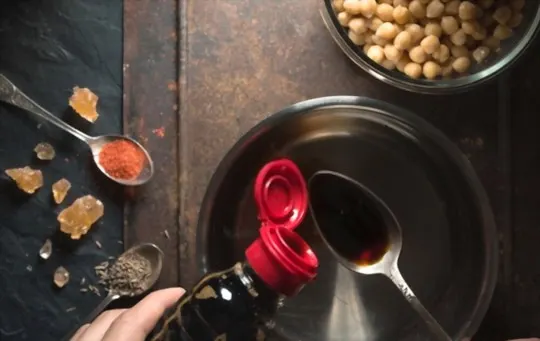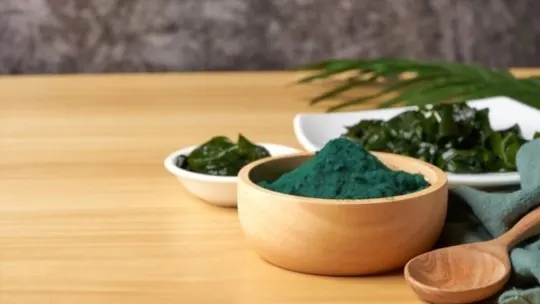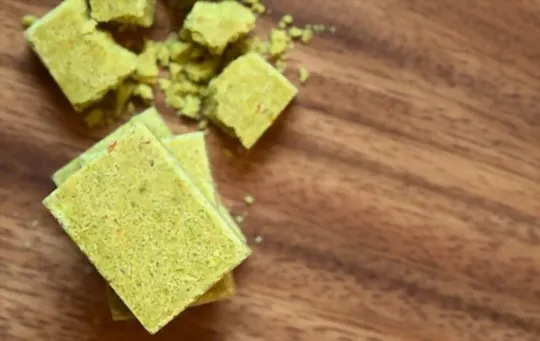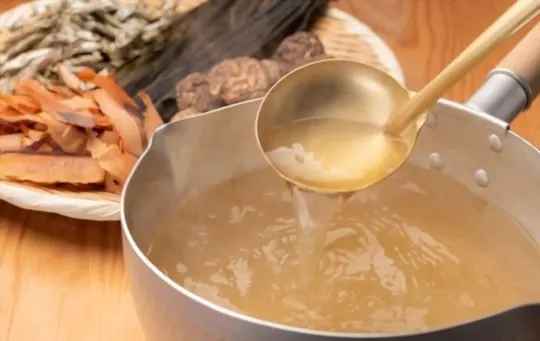Guess what? Finding the perfect dashi substitute just got a whole lot easier.
You’re here because you love cooking, right? Well, so do we.
And, like us, you’ve probably hit that moment where you’re ready to whip up something amazing, only to find you’re out of dashi. Classic move!
No worries, though. Our kitchens are full of secret swap-ins that’ll save the day.
We’ve scoured our pantries and did the taste tests (tough job, but someone had to do it) to bring you the top five picks.
These aren’t your average suggestions; we’re talking about game-changers that’ll keep your dishes singing with that umami goodness we all crave.
Ready to get in on these hacks? Stick around.
What is Dashi?

First, let’s start with what dashi is not: it’s not broth, and it’s not stock.
Dashi is a traditional Japanese ingredient used in many recipes with unique umami-rich flavor and fragrance.
Dashi is often the first taste you’ll experience in a Japanese meal.
Dashi is made from kombu (a type of seaweed) and water.
The liquid dashi can be used as a base for soup or as a cooking liquid for other ingredients.
It’s also added to dishes, such as marinated grilled fish, to add umami richness to the ingredients.
Dashi is best when made with high-quality kombu seaweed, which delivers a delicate flavor enhancing Japanese dishes.
The most common place to buy dashi in Japan is grocery stores, but you might find some specialty varieties if you have access to a Japanese market.
The 5 Best Substitutes for Dashi
Dashi is an essential ingredient in Japanese cuisine, known for its umami-rich flavor and versatility.
It is commonly used as a base for soups, sauces, and other dishes.
However, if you don’t have dashi on hand or are looking for alternatives, there are several substitutes available.
In this guide, we will compare the top 5 substitutes for dashi, discussing their key characteristics and suggesting proper ratios to help you achieve similar flavors in your recipes.
| Substitute | Key Characteristics | Proper Ratio |
|---|---|---|
| Shiitake Mushrooms & Dried Seaweed | Earthy, umami-rich flavor; combination of dried shiitake mushrooms and seaweed creates a similar taste profile | Use 4-6 dried shiitake mushrooms and 1-2 sheets of dried seaweed per liter of water |
| Soy Sauce | Savory, salty flavor with a hint of umami | Use 1 tablespoon of soy sauce per cup of water |
| Instant Dashi Powder | Convenient and easy-to-use powdered dashi that dissolves in hot water | Follow the instructions on the packaging for proper usage |
| Chicken Broth | Rich, savory flavor with a hint of umami from chicken | Use an equal amount of chicken broth as a substitute for dashi |
| Powdered or Cubed Broth | Pre-packaged broth options that come in powdered or cubed form | Follow the instructions on the packaging for proper dilution ratio |
Now let’s explore each substitute in more detail:
1 – Shiitake Mushrooms and Dried Seaweed

If you don’t have access to kombu, dried shiitake mushrooms are a great substitute.
Additionally, seaweed is another fantastic substitute for dashi that will give your dish umami flavor.
The shiitake mushrooms can be added to white or brown rice for taste.
Alternatively, you could grill the mushroom then use it as a side or garnish.
The dried seaweed is typically sold in thin sheets and is called nori.
These are great for making sushi rolls at home and work well with various sauces, such as the classic Japanese dipping sauce for shrimp tempura.
When you buy them, keep in mind that you’ll typically find both dark and light-colored nori.
The dark is smoked while the light is not.
- Key Characteristics: Shiitake mushrooms and dried seaweed provide an earthy, umami-rich flavor that closely resembles dashi. The combination of these ingredients creates a similar taste profile.
- Proper Ratio: Use 4-6 dried shiitake mushrooms and 1-2 sheets of dried seaweed per liter of water. Simmer them in the water for about 20-30 minutes to extract their flavors before using the liquid as a substitute for dashi.
2 – Soy Sauce

Soy sauce is also an excellent substitute for dashi; it has a rich flavor.
Additionally, it’s important to note that there are many different varieties of soy sauce.
When cooking Japanese food, you can use a light or dark soy sauce to substitute for dashi.
Although it’s important to note that soy sauce from China is not the same as Japan, Chinese soy sauce tends to be much saltier and less fragrant than Japanese soy sauce.
In addition, Chinese soy sauce is made from soybeans, while Japanese soy sauce is made from wheat.
In what dishes can you use soy sauce as a substitute for dashi? Well, it’s worth mentioning that soy sauce is an ingredient in many different sauces and marinades.
Its original purpose was to add saltiness and umami flavor to other dishes.
- Key Characteristics: Soy sauce offers a savory, salty flavor with a hint of umami. While it does not replicate the full complexity of dashi, it can add depth to dishes and serve as a simple substitute.
- Proper Ratio: Use 1 tablespoon of soy sauce per cup of water. Adjust the quantity based on your recipe requirements and desired flavor intensity.
3 – Instant Dashi Powder

Instant dashi powder is a type of soup mix sold in Japan.
Like other varieties, it typically comes as a small packet with instructions for preparing the substitute for dashi.
The best part about using instant dashi powder is adjusting the flavor to your tastes by adding more or less to your dishes.
Interestingly enough, this powder is typically made from bonito flakes mixed with seaweed and dried skipjack tuna.
The powder can be used as a soup base and for seasoning and adding umami flavor to many different dishes.
- Key Characteristics: Instant dashi powder is a convenient and easy-to-use substitute that dissolves in hot water. It is specifically designed to mimic the flavor of traditional dashi.
- Proper Ratio: Follow the instructions on the packaging of the instant dashi powder for the proper usage and dilution ratio. This may vary depending on the brand.
4 – Chicken Broth

Although it may not be the first thing you think of, chicken broth is another excellent substitute for dashi.
The most common variety in Japan is called tori dashi, made from both chicken and pork bones.
You can add this broth too many dishes, including soups and other recipes.
In addition, I recommend adding other ingredients such as dried wakame seaweed and soy sauce.
The flavor that results from using these ingredients is rich and umami-packed.
It’s also important to note that the broth should be simmered at a very low temperature, typically for several hours.
You can also use it to make other types of soup.
- Key Characteristics: Chicken broth provides a rich, savory flavor with a hint of umami from chicken. While it differs in taste from dashi, it can still add depth to Japanese-inspired dishes as a substitute.
- Proper Ratio: Use an equal amount of chicken broth as a substitute for dashi. Adjust the quantity based on your recipe requirements and desired flavor intensity.
5 – Powdered or Cubed Broth

Powdered and cubed broths are also great substitutes for dashi.
The powdered broth typically comes as a powder, similar to how instant dashi is packaged.
However, you should note that the consistency and taste of these broths vary significantly by brand.
On the other hand, cubes can be made from chicken and pork.
To prepare them, place them in boiling water.
The broth cubes can also be used in many recipes, including stir-fries and soups.
Depending on the brand, the flavor may vary.
Some have a strong taste of their own, which is why they shouldn’t be used for cooking delicate dishes.
- Key Characteristics: Powdered or cubed broth options, such as vegetable or mushroom broth, can be used as a convenient substitute for dashi. They offer a variety of flavors and are easily accessible.
- Proper Ratio: Follow the instructions on the packaging of the powdered or cubed broth for the proper dilution ratio. This may vary depending on the brand and type of broth.
Conclusion
Dashi is an essential part of Japanese cooking and dishes throughout the country.
However, for those who choose not to eat certain foods or don’t have access to traditional dashi, plenty of substitutes are available.
These include soy sauce, instant dashi powder, chicken broth, powdered broth cubes, and cubed broth.
In each case, it’s important to note that the taste will vary by brand.
When cooking dishes, try adding different ingredients to see which substitute tastes best.

The 5 Best Substitutes for Dashi
Ingredients
- Shiitake Mushrooms and Dried Seaweed
- Soy Sauce
- Instant Dashi Powder
- Chicken Broth
- Powdered or Cubed Broth
Instructions
- Pick your favorite substitute from the list above.
- Follow cooking directions for your selected substitute with the proper ratio of ingredients.

Andrew Gray is a seasoned food writer and blogger with a wealth of experience in the restaurant and catering industries. With a passion for all things delicious, Andrew has honed his culinary expertise through his work as a personal chef and caterer.
His love for food led him to venture into food writing, where he has contributed to various online publications, sharing his knowledge and insights on the culinary world. As the proud owner of AmericasRestaurant.com, Andrew covers a wide range of topics, including recipes, restaurant reviews, product recommendations, and culinary tips.
Through his website, he aims to inspire and educate fellow food enthusiasts, offering a comprehensive resource for all things food-related.

Leave a comment